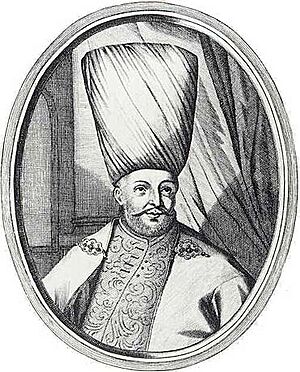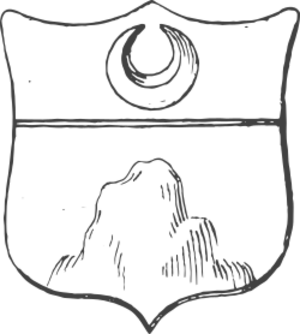Köprülüzade Fazıl Ahmed Pasha facts for kids
Quick facts for kids
Fazıl Ahmed
Pasha
|
|
|---|---|
 |
|
| Grand Vizier of the Ottoman Empire | |
| In office 31 October 1661 – 3 November 1676 |
|
| Monarch | Mehmed IV |
| Preceded by | Köprülü Mehmed Pasha |
| Succeeded by | Kara Mustafa Pasha |
| Personal details | |
| Born | 1635 Vezirköprü (then named Köprü, present-day Samsun Province, Black Sea Region, Turkey) |
| Died | 3 November 1676 (aged 40–41) Constantinople, Ottoman Empire |
| Nationality | Ottoman |
| Relations | Köprülüzade Fazıl Mustafa Pasha (brother) Köprülüzade Numan Pasha (nephew) Kara Mustafa Pasha (brother-in-law) Abaza Siyavuş Pasha (brother-in-law) Amcazade Köprülü Hüseyin Pasha (cousin) |
| Parents | Köprülü Mehmed Pasha (father) Ayşe Hatun (mother) |
| Origins | Albanian (father), Turkish (mother) |
| Family | Köprülü family |
| Military service | |
| Allegiance | |
| Battles/wars | Austro-Turkish War (1663–64)
|
Fazıl Ahmed Pasha was an important leader in the Ottoman Empire. He was born in 1635 and died on November 3, 1676. He belonged to the famous Köprülü family, which was known for producing many powerful leaders. Six members of his family became the Grand Vizier, a very high position in the Ottoman government.
Contents
Who Was Fazıl Ahmed Pasha?
Fazıl Ahmed Pasha was a skilled statesman and military commander. He played a key role in the Ottoman Empire during the 17th century. His leadership helped shape many important events of his time.
His Early Life and Family
Fazıl Ahmed Pasha was born into the Köprülü family. His father was Köprülü Mehmed Pasha, a well-known Ottoman general. His mother was Ayşe Hatun. The Köprülü family name came from a bridge built by his mother's family. This bridge was in a village called Köprü, where his father was stationed.
Becoming a Grand Vizier
Fazıl Ahmed Pasha followed in his father's footsteps. He became the Grand Vizier in 1661. He held this powerful position until 1676. Before becoming Grand Vizier, he served as a governor in other parts of the Ottoman Empire. He governed Damascus Eyalet from 1660 to 1661. He also governed Erzurum Eyalet from 1659 to 1660.
A Wise Leader and Brave General
Fazıl Ahmed Pasha was known as Fazıl, which means "wise." He earned this name because he worked to lower taxes for people. He also supported education, which was very important. However, he was also a tough leader during wartime. He led the Ottoman Army in several major conflicts.
Important Battles and Treaties
Fazıl Ahmed Pasha led the Ottoman forces in the Austro-Turkish War (1663–64). His goal was to conquer parts of Austria and even Vienna. In 1664, his army destroyed Novi Zrin after a long siege. Even though the Ottomans lost the Battle of Saint Gotthard, he still gained land through the Peace of Vasvár treaty.
After this war, he focused on the Cretan War. In 1669, he successfully captured Candia (now Heraklion) from the Republic of Venice. He also led campaigns in the Polish–Ottoman War (1672–1676). This war ended with the signing of the Treaty of Buchach in 1672 and the Treaty of Żurawno in 1676.
Fazıl Ahmed Pasha passed away on November 3, 1676.
See Also
- Köprülü family
- Köprülü era of the Ottoman Empire
- List of Ottoman grand viziers
- List of Ottoman governors of Damascus
Images for kids



